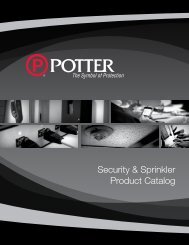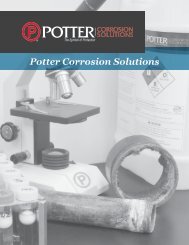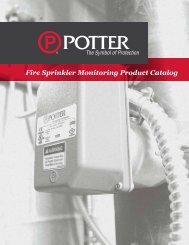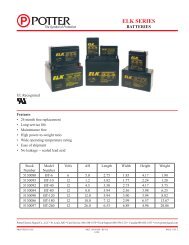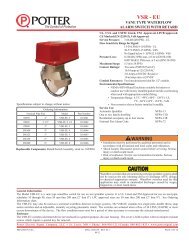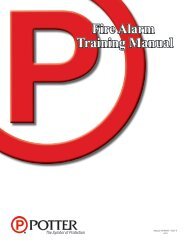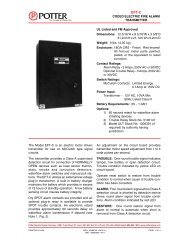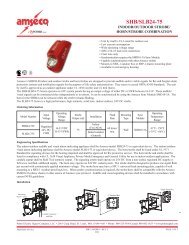Training Manual - Potter Electric Signal Company, LLC
Training Manual - Potter Electric Signal Company, LLC
Training Manual - Potter Electric Signal Company, LLC
Create successful ePaper yourself
Turn your PDF publications into a flip-book with our unique Google optimized e-Paper software.
Determine Fire Alarm Requirements<br />
NFPA 101 Life Safety Code determines the fire alarm requirements based on the occupancy rating of the building.<br />
Within each occupancy chapter, section 3.4 will specify the fire alarm requirements for that occupancy class.<br />
Section 3.4 is “Detection, Alarms & Communication”. Section 3.5 is “Extinguishing Requirements”.<br />
Section 3.4 Detection, Alarms and Communication<br />
The General Provision<br />
Specifies the conditions under which a fire alarm is required in that particular occupancy.<br />
The Initiation Provision<br />
Specifies how the fire alarm will be activated, other than as relates to automatic fire detection. It is typical in<br />
many occupancy chapters that the Initiation provision call for “<strong>Manual</strong> activation in accordance with 9.6.2.1”.<br />
When referred to chapter 9, only the applicable portions of chapter 9 apply for that occupancy.<br />
The Notification Provision<br />
Specifies “On Premises” signaling requirements. It may require voice evacuation, and may permit or prohibit<br />
the use of “Pre-<strong>Signal</strong>” features.<br />
The Detection Provision<br />
Specifies requirements for automatic detection.This section should always be reviewed, even if the building is<br />
not required to have a fire alarm system under the general statement for that occupancy class.<br />
The Emergency Forces Notification Provision<br />
Includes any requirement for “Off Premises” signaling (monitoring).<br />
Section 3.5 Extinguishing Requirements<br />
Specifies requirements for automatic sprinkler systems. Refers to chapter 9 section 9-7 “Automatic Sprinklers<br />
and other Extinguishing Equipment”<br />
The code may require either an, approved automatic sprinkler or an approved supervised automatic sprinkler.<br />
Where a supervised automatic sprinkler is required, NFPA 101 2009 9-7.2.1 and 9-7.2.2 are applicable.<br />
Sprinkler System Supervision Includes:<br />
Water flow<br />
Water Supply Control Valves<br />
Fire Pump Status<br />
Water Tank, Levels and Pressures<br />
Air Pressure on Dry Pipe Systems<br />
Building Temperature<br />
Fire Alarm <strong>Signal</strong>s<br />
A. Alarm: A signal indicating a fire emergency.<br />
1. Automatic water flow device<br />
2. <strong>Manual</strong> fire alarm station (pull station)<br />
3. Automatic fire detectors (smoke or heat detectors)<br />
B. Supervisory: A signal indicating an “off-normal” condition exists on the extinguishing system.<br />
1. Control valve switch<br />
2. High/low air pressure switch<br />
3. Water tank level and temperature switches<br />
4. Low water pressure for public water supplies<br />
5. Low building temperature switch<br />
6. Water Column Switch<br />
C. Trouble: A signal indicating a problem with the fire control panel or associated wiring which may<br />
render the system inoperable.<br />
1. Loss of primary power (120VAC)<br />
2. Loss of secondary power (battery)<br />
3. A defect in the supervised wiring to an initiating device, indicating appliance or extinguishing<br />
agent release device.<br />
4. Disabled circuit or function<br />
5. Failure to communicate with central station<br />
Types Of Sprinkler Systems<br />
Wet Pipe Sprinkler System<br />
Wet systems are the most common and reliable sprinkler systems since no equipment other than the sprinkler<br />
heads are required to operate. Wet systems use automatic sprinkler heads attached to piping containing water<br />
and connected to a water supply so that water will be discharged immediately from an open sprinkler. Water will<br />
only be discharged through heads that have opened due to fire.<br />
Dry Pipe Sprinkler System<br />
Dry pipe systems use automatic sprinklers attached to a piping system pressurized with air. These systems use<br />
a dry pipe valve and air pressure to hold back the water supply. When the air pressure in the system bleeds<br />
off due to an open sprinkler, the water pressure will open the valve and fill the system. The water will only<br />
be discharged through the heads that have opened due to fire. Dry systems are usually installed in unheated<br />
buildings or where there is the possibility of sprinkler pipes freezing.<br />
Water supply control valves shall be supervised to obtain a distinctive signal when in an off normal position,<br />
within 2 revolutions of the handwheel, or when the valve has moved one fifth from its normal position.<br />
The switch shall not restore to a normal condition throughout the entire travel of the valve, until it is restored to<br />
a fully open position.<br />
A Supervisory signal must be visually or audibly distinctive from both Alarm and Trouble signals.<br />
Water flow and supervisory devices cannot be connected on the same initiating circuit so that the closing of a<br />
valve is annunciated as a “trouble” condition.<br />
14 15



